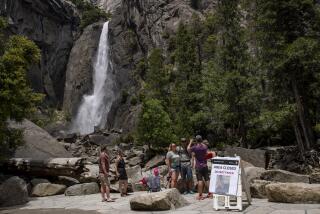Yosemite Puts Out the Welcome Sign
- Share via
SACRAMENTO — Not for 40 years has a U.S. president visited Yosemite National Park. The last one to do so was John F. Kennedy, who, in a sign of the times, dropped in between dedicating two Western dams. So, when it seemed last year that President Bush would be the first in four decades to visit Yosemite, the valley was atwitter with preparation and advance scouting by Secret Service teams. When Bush changed his itinerary, park officials weren’t too disappointed, because the first lady came instead.
Laura Bush’s visit, it turned out, was purely recreational--an outdoor outing for the first lady and a handful of pals known in this administration as “the MGs,” for the “Midland Girls,” a circle of friends from back home in West Texas. Reports are that the women so enjoyed their backpacking trek across the High Sierra that they made their National Park Service interpretive guide “an honorary MG.”
National Park Service Supt. David A. Mihalic is not unduly upset that the 40-year streak remains unbroken. “If the president finds time to come out here, I think that’s great,” Mihalic said in an interview. “His wife has been here. As an educator, I think she got a lot out of it.”
While brought on board to facilitate the Yosemite Valley Plan to limit traffic congestion, Mihalic seems to have a different mission. The Bush administration, it seems, is trying to make national parks as accessible as possible, gridlock or not. In part, this is because surveys indicate that, in these times of slow economic growth and terrorist scares, national parks are among the safest places in which to vacation.
But the general public’s visits to Yosemite have been trending downward the last five years. Since peaking at 4.2 million visitors in 1996, annual visitation dropped to some 3.5 million park attendees in 2001. A couple of factors may have been at work. In January 1997, a big flood washed away some of the park’s capacity to accommodate overnighters. Second, 1996 was the year that park authorities attracted widespread news coverage for temporarily bringing down the gates and denying cars entrance. Since then, Californians may have steered clear of the park because of a misconception that getting turned away actually occurs more frequently than it does. In fact, Memorial Day weekend in May 1996 was the last time it happened.
After the flood, as parties worked on the Yosemite Valley Plan for future park management, talk surfaced of requiring a day-use reservation system to regulate traffic flow in the Valley. That notion faded, however, as feedback indicated that the public feared it might restrict access to all but the well-heeled overnight hotel guests.
Automobile congestion in the seven-mile-long Yosemite Valley is still a big concern, most notably during the height of the travel season. Park spokesman Scott Gediman says that 95% of park visitors are destined for its picturesque valley. Conversely, the popular Yosemite Valley comprises just 5% of the park’s entire acreage. Authorities figure if they can get more visitors to leave their vehicles on the park’s fringes and head into the valley on shuttle buses, they’ve got a big part of the overcrowding problem licked.
Technically, park service folk are supposed to be above worrying about head counts at the gate. “We are not in the business of encouraging or discouraging visitation, just providing the quality visitor experience,” says Gediman. But dramatic drops can be a source of consternation for the corporation that runs park concessions, the surrounding “gateway” communities and others who depend upon the trickle-down economy of Yosemite tourism. GOP Rep. George Radanovich, who grew up in the region and often complains about the shortage of parking spaces and campgrounds in the Valley, is merely giving voice to his constituents when he makes a big stink about it.
As for Mihalic, he clearly wants to get the word out that Yosemite is open for business, particularly in the post-Sept. 11 climate.
Addressing a group of journalists in January, Mihalic extolled the park as a getaway destination, pointing out that Los Angelenos “don’t have to go through airport security to get here....We’re just a six-hour drive away.
“I don’t believe in turning people away, even if there’s gridlock.” Mihalic went on to say. “I will go out on a limb and say I do not see a day when cars will be turned away.”
His remarks suggested a move away from preventing gridlock to an open-armed invitation to visit the park, come what may. “We are trying to make a visit to this place an easy thing to do,” Mihalic says. “I wouldn’t be surprised if the visitation went up.”
Appointed by the Clinton administration in 1999, Mihalic is nothing if not a survivor. “The new administration pretty much wants this place to stay the same year after year after year, so that you would not come back and say, ‘Gee, we’re disappointed.’ I think it will be a sad day if we can’t take in the family that says, ‘Kids, we’re going to Yosemite!’” Mihalic says.
As for a visit by President Bush, Mihalic says, “Whether the president comes to Yosemite or not is really not as important as whether he understands what the park does for the American people.”
In the meantime, the 40-year streak holds, and Yosemite lure, lore and legend continue to grow. To this day, stories are still shared of Kennedy’s visit and how, from time to time, in the second-floor Ahwahnee Hotel suite in which he slept, a chair is occasionally seen rocking with no one in it. On windless days, no less. As presidential visits go, perhaps that will have to do for now.
More to Read
Sign up for The Wild
We’ll help you find the best places to hike, bike and run, as well as the perfect silent spots for meditation and yoga.
You may occasionally receive promotional content from the Los Angeles Times.






